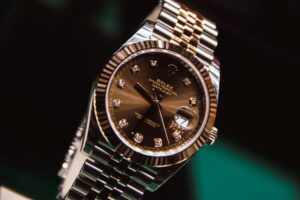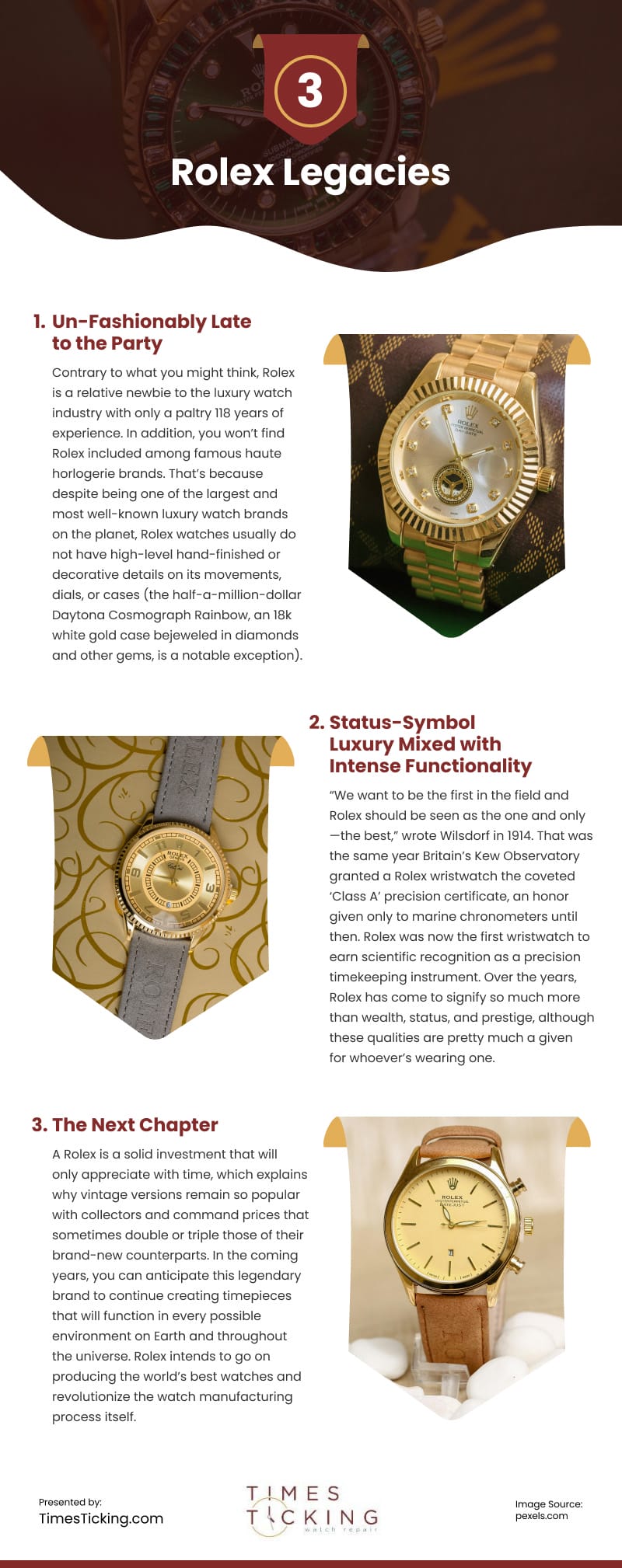Watch and Clock Repair Blog
With all the charm of a secretive Swiss bank and mostly unchanging, utilitarian designs, you’d imagine Rolex timepieces would sooner belong in a museum than on someone’s wrist. And yet, if someone were to ask you to think of an iconic luxury watch company, Rolex would likely be the first to come to mind.

Un-Fashionably Late to the Party
Contrary to what you might think, Rolex is a relative newbie to the luxury watch industry with only a paltry 118 years of experience. Vacheron Constantin dates back to 1755, and Blancpain’s roots stretch further to 1735. Even Omega, generally considered its top competitor, arrived on the scene 57 years earlier than Rolex.
In addition, you won’t find Rolex included among famous haute horlogerie brands, such as Vacheron Constantin, Audemars Piguet, Patek Philippe, A. Lange & Söhne, and Breguet. That’s because despite being one of the largest and most well-known luxury watch brands on the planet, Rolex watches usually do not have high-level hand-finished or decorative details on its movements, dials, or cases (the half-a-million-dollar Daytona Cosmograph Rainbow, an 18k white gold case bejeweled in diamonds and other gems, is a notable exception).
Rolex founder Hans Wilsdorf and his partner did not seek to make luxurious works of art, per se. They wanted to create watches that people all over the world would recognize as top-of-the-line timekeeping machines that push the envelope in scientific and technological advancement.
And they did.
Status-Symbol Luxury Mixed with Intense Functionality
Born in 1881 in Kulmbach, Bavaria (southern Germany), Hans Eberhard Wilhelm Wilsdorf learned self-reliance early in life. He was orphaned at the age of 12, lived as a Protestant in heavily-Catholic Bavaria, and built a thriving business in London during the First World War when Germans weren’t very popular among the British.
He was a self-made man in every sense of the word. That drive, coupled with a keen interest in watchmaking and an entrepreneurial spirit, would prove the secret to the immense success of one of the greatest watch brands in history.
“We want to be the first in the field and Rolex should be seen as the one and only—the best,” wrote Wilsdorf in 1914. That was the same year Britain’s Kew Observatory granted a Rolex wristwatch the coveted ‘Class A’ precision certificate, an honor given only to marine chronometers until then. Rolex was now the first wristwatch to earn scientific recognition as a precision timekeeping instrument.
It would be the first of many firsts to include:
1926 – The first hermetically-sealed, waterproof wristwatch, the Oyster.
1927 – The first watch company to use the celebrity testimonial concept (and succeed brilliantly at it).
1931 – The world’s first Perpetual (self-winding) movement.
1933 – The first watch to function at a land-speed record of more than 300mph on the wrist of race car driver Sir Malcolm Campbell.
1945 – The first wrist chronometer to feature a date window on the dial, the Datejust.
1953 – The first wristwatch to summit Mt. Everest with Sir Edmund Hillary and Tenzing Norgay.
1953 – The first diver’s watch that remained waterproof to 100m, the Submariner.
2007 – The first watch ever equipped with a programmable countdown featuring a synchronizable mechanical memory, the Yacht Master II.
2012 – The first experimental diver’s watch certified waterproof to 12,000m, the Deep Sea Challenge.
Over the years, Rolex has come to signify so much more than wealth, status, and prestige, although these qualities are pretty much a given for whoever’s wearing one. Their brand represents a force of nature—unmatched mechanical prowess and the promise of high-class adventure, worn and adored by wealthy men and women alike, just as Wilsdorf intended.
The Next Chapter
With worldwide name recognition and products that can hold or exceed their value over several lifetimes, don’t expect Rolex to change its sales or manufacturing philosophies anytime soon. The company produces roughly one million timepieces annually and maintains tight controls on retail pricing to keep demand high and supply low. They also restrict selling genuine Rolex parts to anyone but their own authorized watch repair centers in order to maintain product quality and continuity. This move forced most independent Rolex watch repair experts to turn to the gray (secondary) market in order to repair vintage timepieces.
Another key to the brand’s overwhelming success is that the price points for its timepieces mostly fall into that sweet spot between attainable luxury and you-will-never-be-able-to-afford-it exorbitance. Unlike with the haute horlogerie brands, you know every penny you’re paying with a Rolex is for top-tier accuracy and durability, not artistic flair, so you can (somewhat) justify the $10,000- to $30,000-price tag. A Rolex is a solid investment that will only appreciate with time, which explains why vintage versions remain so popular with collectors and command prices that sometimes double or triple those of their brand-new counterparts.
In the coming years, you can anticipate this legendary brand to continue creating timepieces that will function in every possible environment on Earth and throughout the universe. With its own internal research and development department and numerous professionally-equipped science labs, Rolex intends to go on producing the world’s best watches and revolutionize the watch manufacturing process itself.
Hans Wilsdorf would be proud.
Infographic
Rolex, a leading luxury watchmaker, combines discreet sophistication with robust functionality, establishing itself as a symbol of timeless luxury. Founded by Hans Wilsdorf in World War I, the brand has achieved milestones like the first waterproof wristwatch and self-winding movement. With strict control over pricing and distribution, Rolex positions its timepieces between attainable luxury and exclusive extravagance, making them a solid investment. The brand continues to innovate, producing watches for extreme conditions, honoring Hans Wilsdorf’s legacy in luxury timekeeping.

